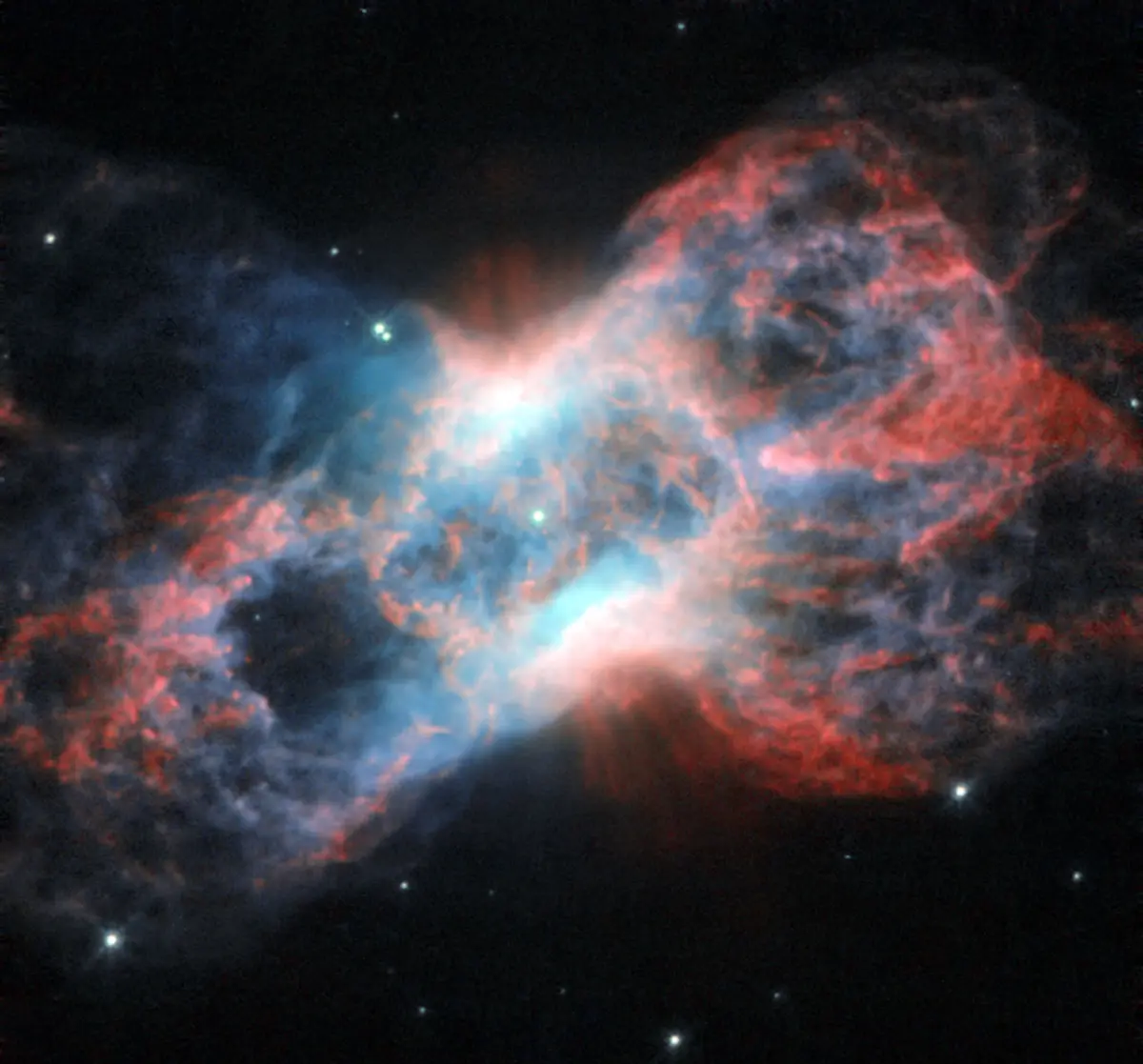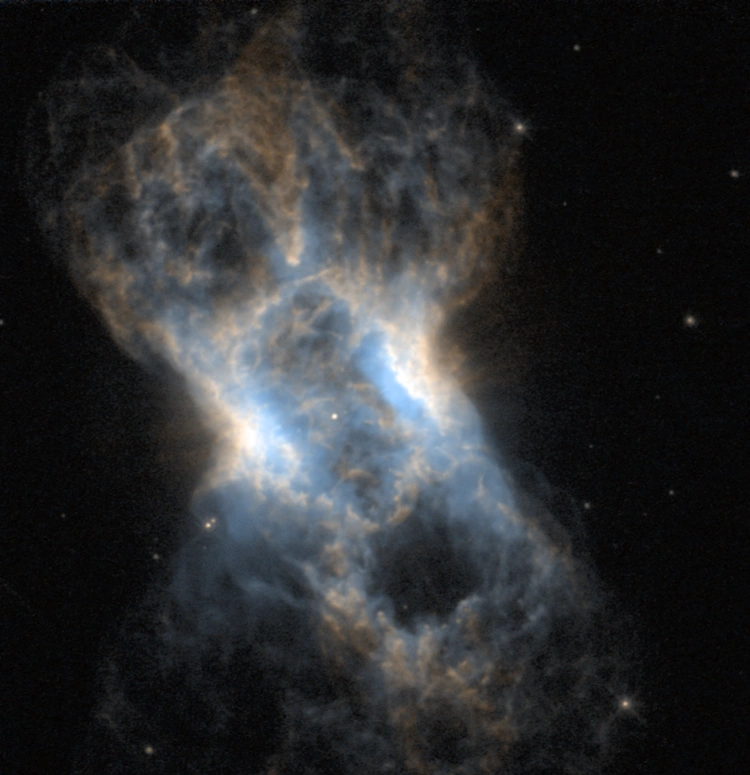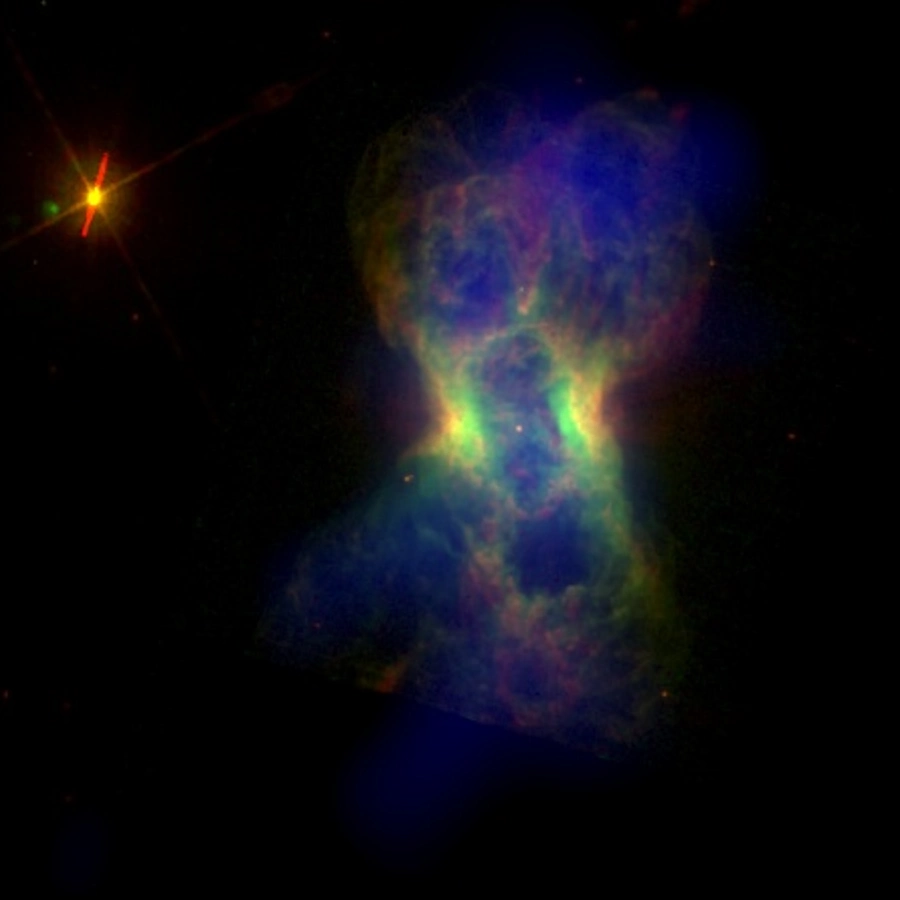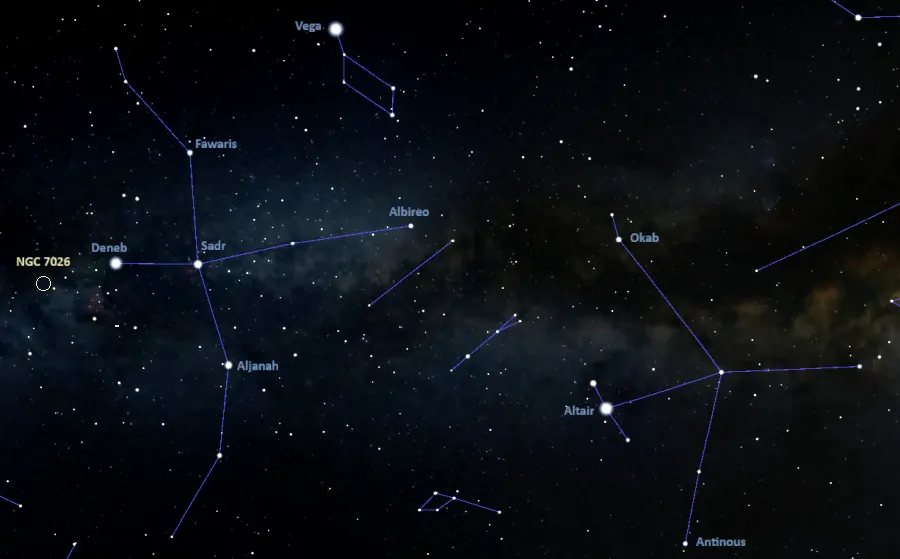The Cheeseburger Nebula is a planetary nebula located approximately 6,000 light-years away in the northern constellation of Cygnus. It has an apparent size of 0.590 by 0.378 arcminutes and an apparent magnitude of 15.33. It has the designation NGC 7026 in the New General Catalogue.
NGC 7026 formed when an evolved star reached the late stages of its life cycle and expelled its outer layers into space. The gaseous material forms the planetary nebula and is ionized by the strong ultraviolet light of the central stellar remnant. The nebula’s intricate structure reveals multiple episodes of mass loss from the central star.
The Cheeseburger Nebula has a highly complex bipolar structure. It contains a fast-expanding equatorial waist, three entangled pairs of lobes, and four sets of high-speed knots of emission. The bipolar lobes are emitting X-rays, which were detected by the XMM-Newton telescope. The X-rays indicate that the temperature of the escaping gas in the nebula is about 1.1 million K.

This image from the NASA/ESA Hubble Space Telescope shows NGC 7026, a planetary nebula. Located just beyond the tip of the tail of the constellation of Cygnus (The Swan), this butterfly-shaped cloud of glowing gas and dust is the wreckage of a star similar to the Sun. Planetary nebulae, despite their name, have nothing to do with planets. They are in fact a relatively short-lived phenomenon that occurs at the end of the life of mid-sized stars. As a star’s source of nuclear fuel runs out, its outer layers are puffed out, leaving only the hot core of the star behind. As the gaseous envelope heats up, the atoms in it are excited, and it lights up like a fluorescent sign. Fluorescent lights on Earth get their bright colours from the gases they are filled with. Neon signs, famously, produce a bright red colour, while ultraviolet lights (black lights) typically contain mercury. The same goes for nebulae: their vivid colours are produced by the mix of gases present in them. This image of NGC 7026 shows starlight in green, light from glowing nitrogen gas in red, and light from oxygen in blue (in reality, this appears green, but the colour in this image has been shifted to increase the contrast). As well as visible light, NGC 7026 emits X-ray radiation, and has been studied by ESA’s XMM-Newton space telescope. X-rays are a result of the extremely high temperatures of the gas in NGC 7026. This image was produced by the Wide Field and Planetary Camera 2 aboard the Hubble Space Telescope. The image is 35 by 35 arcseconds. Image credit: ESA/Hubble & NASA; Acknowledgement: Linda Morgan-O’Connor (CC BY 3.0)
The brightest portion of the nebula has a binuclear appearance, which has led to the popular nickname the Cheeseburger Nebula. NGC 7026 itself extends far beyond the central region.
The nebula is formed by multiple filamentary loops. It contains cometary knots along the inner edges of the prominent lobes. Hubble images have revealed the four emission knots that appear beyond the lobes. These knots form point-symmetric pairs. Some of them have velocities of around 180 km s-1.
The lobes and knots open out as material speeds away from the nebula’s core. The nebula has an expansion velocity of 150 km s-1 along the main symmetry axis. The bright central waist is expanding at around 57 km s-1.
The central star of the Cheeseburger Nebula is a binary system. Like the central star of the Little Ghost Nebula (NGC 6369) in the constellation Ophiuchus, it has the spectral type [WO3], indicating a spectrum similar to that of an oxygen-rich Wolf-Rayet star. However, it is not a true Wolf-Rayet star. The central star of NGC 7026 is a less massive post-asymptotic giant branch (AGB) star that was similar to our own Sun while on the main sequence. It has since ceased fusion in its core and shed its atmosphere to reveal a carbon-oxygen core.

Cheeseburger Nebula (NGC 7026), image based on observations made with the NASA/ESA Hubble Space Telescope, and obtained from the Hubble Legacy Archive, which is a collaboration between the Space Telescope Science Institute (STScI/NASA), the Space Telescope European Coordinating Facility (ST-ECF/ESA) and the Canadian Astronomy Data Centre (CADC/NRC/CSA). credit:NASA/ESA Hubble Space Telescope (CC BY-SA 3.0)
Facts
NGC 7026 was discovered by the American astronomer Sherburne Wesley Burnham on July 6, 1873. It is sometimes also known as Burnham’s Nebula. Burnham observed the nebula in a 6-inch Clark refractor.
English astronomer Ralph Copeland discovered the nebula independently with a 6.1-inch refractor from the Dun Echt Observatory in Scotland on November 18, 1880.
Danish astronomer John Louis Emil Dreyer, who included the nebula in his New General Catalogue of 1888, described the object as a “fairly bright planetary nebula with two nuclei.”
NGC 7026 was nicknamed the Cheeseburger Nebula by the American amateur astronomer Jay McNeil in 1999. The nebula is not to be mistaken for Gomez’s Hamburger, a young A-type star surrounded by a protoplanetary disk located in the constellation Sagittarius. Unlike NGC 7026, Gomez’s Hamburger looks exactly like the food it was named after.

NGC 7026 captured by the Chandra X-ray Observatory (PD)
Location
The Cheeseburger Nebula appears in the region of the Northern Cross, a prominent northern asterism formed by the brightest stars of Cygnus (the Swan). The nebula lies near the supergiant Deneb, the constellation’s brightest star, in the same area as the better-known North America Nebula (NGC 7000), the Pelican Nebula (IC 5070), and the open cluster Messier 39. NGC 7026 can be found 12 arcminutes north-northwest of the orange bright giant or supergiant 63 Cygni (mag. 4.56).
Many other deep sky objects appear in the same region of the sky, including the open clusters NGC 6996 and NGC 6997, NGC 7067, NGC 7062 and NGC 7031, the emission nebula IC 5068 (the Forsaken Nebula), the Jewel Bug Nebula (NGC 7027), the Moth Nebula (Sh1-89) and the open cluster IC 1369, the Peekaboo Nebula (NGC 7048), and the reflection nebula IC 5076.

NGC 7026 location, image: Stellarium

The Cheeseburger Nebula, North America Nebula, Pelican Nebula, Messier 39, IC 5076, IC 1369, NGC 7039 and the Funnel Cloud Nebula, image: Stellarium
The Cheeseburger Nebula is best seen in large telescopes at high magnification with an Oxygen-III filter. The nebula has high surface brightness and can be seen in a small telescope. However, with a small apparent size, it is indistinguishable from the surrounding stars. The nebula’s lobes can be spotted in 12-inch or larger instruments.
The best time of the year to observe the Cheeseburger Nebula and other deep sky objects in Cygnus is during the month of September, when the celestial Swan dominates the early evening sky. At declination 48°, the nebula is best seen from the northern hemisphere. It never rises above the horizon for observers south of the latitude 42° S.
Cheeseburger Nebula – NGC 7026
| Constellation | Cygnus |
| Object type | Planetary nebula |
| Right ascension | 21h 06m 18.5723414928s |
| Declination | +47° 51′ 06.774735780″ |
| Apparent magnitude | 10.9 |
| Apparent size | 20″ (optical); 0.590 x 0.378′ (near-infrared) |
| Distance | 6,000 light-years (1,839.61 parsecs) |
| Names and designations | Cheeseburger Nebula, NGC 7026, PN ARO 59, PN VV’ 542, PN VV 260, PK 089+00 1, PN G089.0+00.3, CSI+47-21046, HD 201192, DO 39213, EM* CDS 1218, GCRV 13271, HBHA 4703-62, WEB 18972, GSC2 N0331022145839, GT 2104+476, [KW97] 55-39, [TGC96] 2104+4739, PLX 5080.00, IRAS 21046+4739, 2MASX J21061823+4751071, Gaia DR2 2165238733564304768, Gaia DR3 2165238733564304768 |